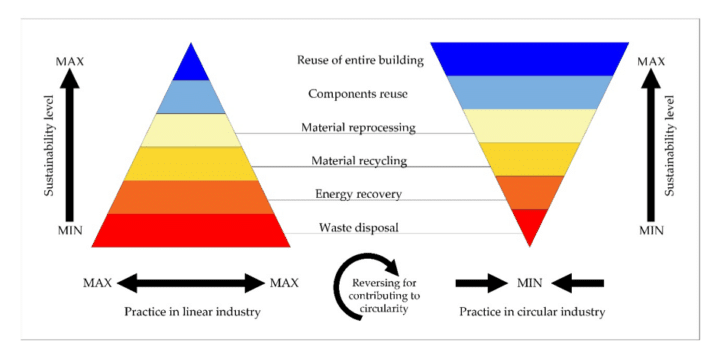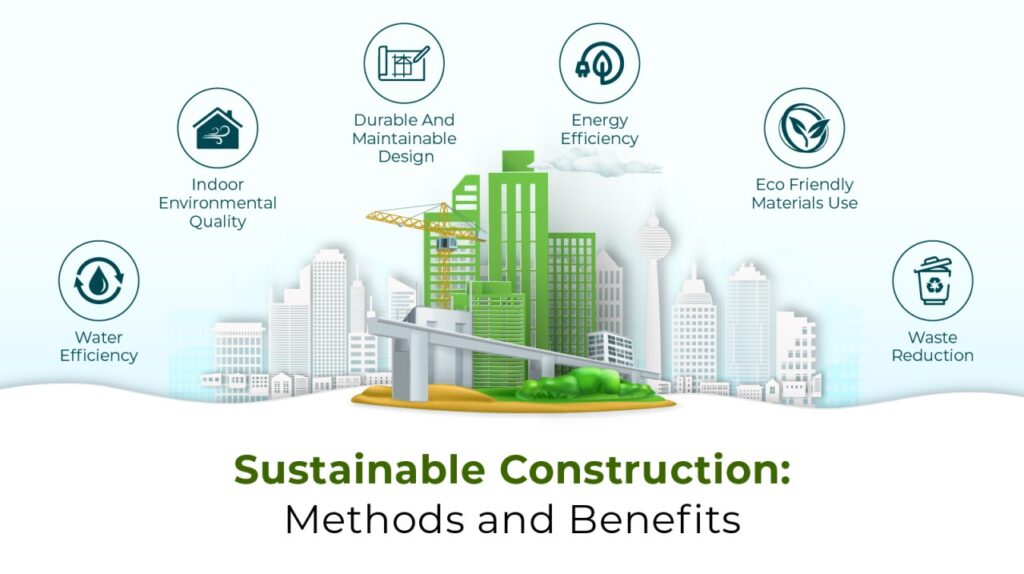Recycling in Construction: A New Era of Sustainability
The construction industry generates a staggering amount of waste each year, with millions of tons of materials ending up in landfills. This waste not only takes up valuable space but also contributes to environmental degradation through pollution and resource depletion. However, there’s a growing movement towards sustainability in construction, emphasizing the importance of recycling materials. By recycling, we can significantly reduce the environmental impact of construction projects, conserve natural resources, and even save money.
This blog will explore how to recycle construction materials effectively, from assessing what can be recycled to finding the right facilities and incorporating innovative practices. We’ll also delve into the benefits of on-site reuse and the latest trends in construction recycling. Whether you’re a contractor, builder, or DIY enthusiast, understanding how to manage construction waste responsibly is crucial. With a little planning and the right approach, recycling construction materials can be straightforward and advantageous. Join us as we guide you through practical steps and insights to make your construction projects more sustainable and eco-friendly.
Assessing Recyclability of Construction Materials
When assessing what construction materials you can recycle, it’s crucial to identify and categorize common recyclable materials. Construction sites frequently generate concrete, wood, metals, and plastics, which are prime candidates for recycling. However, the condition of these materials significantly impacts their recyclability.
Reuse or chip uncontaminated wood for mulch. Crush and repurpose clean, separated concrete as aggregate for new construction. Highly recyclable metals like steel and aluminum retain their properties through multiple recycling processes. Depending on their type, you can also reprocess plastics into new products.
The condition of the materials plays a vital role in determining their recyclability. Properly identifying, separating, and handling these materials can maximize their potential for recycling and minimize waste.
To determine if materials are suitable for recycling, inspect them for contamination, damage, or mixed materials that could complicate the recycling process. Utilizing tools and resources like local recycling guides or dedicated recycling apps can aid in this assessment. These resources provide detailed information on the recyclability of specific materials and the nearest facilities equipped to handle them. By thoroughly assessing and identifying recyclable materials, construction projects can significantly reduce waste and contribute to a more sustainable building practice.
Designing for Deconstruction and Recycling
Planning for recycling during construction starts with designing buildings for deconstruction, a strategy that significantly simplifies future recycling efforts. When architects and builders design structures with the end of their lifecycle in mind, they select materials and construction methods that are easier to disassemble and recycle. For example, using screws instead of nails and opting for modular components can make the deconstruction process more efficient and less wasteful. On-site sorting of materials during construction and demolition is another critical practice. By segregating materials such as wood, metal, concrete, and plastics at the source, it becomes easier to divert these items from landfills and send them to appropriate recycling facilities.
This method not only reduces environmental impact but also minimizes disposal costs and can even generate revenue from the sale of recyclables. Collaboration with contractors who prioritize recycling and waste management is equally important. These professionals bring expertise and resources to ensure that recycling plans are effectively implemented. They can provide the necessary equipment, like designated recycling bins, and manage the logistics of transporting materials to recycling centers. By integrating these practices into the construction process, builders can contribute to sustainable development and significantly reduce the environmental footprint of their projects.
Discover Recycling Solutions Near You
Finding recycling facilities for construction materials is a crucial step in managing waste responsibly. Start by identifying local options; many municipalities offer directories or online resources listing nearby recycling centers. Websites like Earth911 and RecycleNation can be invaluable for locating facilities that accept construction debris. Additionally, reach out to local government offices or waste management authorities for recommendations.
Specialty recyclers play a significant role, especially for materials like metals, concrete, or hazardous waste, which require specific handling processes. These recyclers often have the expertise and equipment to process materials efficiently and safely. To find these specialists, search online for businesses dedicated to specific types of recycling, or consult industry directories. Networking with local recycling groups or professional organizations can also provide valuable leads. These groups often have insider knowledge and can recommend reputable facilities or services.
Engaging with community forums or attending local environmental events can further expand your network, offering practical insights and support. By leveraging these resources, you can ensure your construction materials are recycled appropriately, contributing to environmental sustainability and possibly even discovering cost-saving opportunities.
Strategies for Cost Savings and Environmental Impact Reduction
Transporting construction materials to recycling facilities efficiently is crucial for minimizing both costs and environmental impact. One effective strategy is to plan transport routes that optimize fuel usage and reduce travel distance. Grouping materials by type and destination can also streamline the process, ensuring fewer trips are needed. Utilizing rental services such as dumpsters designed specifically for recyclable materials is another smart approach. These services often provide bins for different types of recyclables, making on-site sorting easier and more efficient.
Furthermore, they typically include pick-up and drop-off services, which saves time and reduces the hassle of managing transportation logistics. For larger projects, bulk hauling can be particularly advantageous. This involves collecting large quantities of recyclable materials and transporting them in one go, which can significantly cut down on trips and fuel consumption. Organizing bulk hauling requires coordination with recycling facilities to ensure they can handle the volume and proper scheduling to align with project timelines. By implementing these methods, construction sites can manage waste more sustainably, reducing their carbon footprint and contributing to a circular economy.
On-Site Material Reuse: A Cost-Effective and Sustainable Construction Strategy
Reusing materials on-site is a smart and sustainable practice that can significantly enhance the efficiency of construction projects. One creative reuse idea involves using salvaged wood from demolition for new structures. This wood can be repurposed for flooring, paneling, or even as decorative elements, adding a unique aesthetic while conserving resources.
The economic benefits are substantial; by reusing materials, projects can reduce the need for new purchases, thus lowering overall costs. Additionally, it minimizes waste disposal fees and the environmental impact associated with manufacturing new materials. For instance, a case study from a renovation project in Portland, Oregon, demonstrated the effectiveness of on-site reuse. The project team salvaged timber beams and bricks from the existing structure, integrating them into the new design. This not only preserved the historical value of the materials but also saved the project an estimated 15% on material costs.
Another example is a community center in Austin, Texas, which reused concrete slabs and metal fixtures from the old building in its new construction, achieving both cost efficiency and sustainability. These case studies illustrate that with a bit of creativity and planning, reusing materials on-site can lead to impressive economic and environmental outcomes.
Innovations are Driving a Greener Future
Innovators are transforming the construction industry by introducing new technologies and sustainable practices for recycling. They are revolutionizing waste management by deploying mobile recycling units that can be transported directly to construction sites. These units enable on-site processing of materials like concrete and wood, reducing the need for transportation and lowering carbon emissions. Advanced sorting systems, employing AI and robotic technology, are enhancing the efficiency and accuracy of separating recyclable materials from debris. These systems ensure that more waste is diverted from landfills.
Manufacturers are gaining traction with sustainable construction materials designed with end-of-life recyclability in mind. Materials such as recycled steel, reclaimed wood, and biodegradable composites make it easier to reuse and repurpose construction components. These materials not only minimize environmental impact but also promote a circular economy within the construction sector. Innovators are actively developing and implementing solutions that reduce waste, conserve resources, and promote sustainability throughout the construction lifecycle.
Looking ahead, the future of construction recycling is promising. Trends indicate a growing adoption of green building certifications, such as LEED, which emphasize the use of recyclable materials and waste reduction strategies. The industry is also seeing advancements in 3D printing technology, using recycled materials to create new building components. As the construction industry continues to innovate, these practices and technologies will play a crucial role in making sustainable construction the standard rather than the exception.
Embrace Sustainable Construction: Start Recycling Construction Materials Today
We must actively recycle construction materials to significantly reduce environmental impact and promote sustainability in the building industry. Begin by identifying recyclable materials like concrete, wood, metals, and plastics, and assess their condition carefully. Plan for recycling during the construction process by sorting materials on-site and collaborating with eco-conscious contractors. Find local recycling facilities and specialty recyclers to properly dispose of materials, utilizing efficient transportation and logistics strategies to minimize carbon footprints. Reuse materials on-site whenever possible and explore innovative trends and technologies that are transforming construction recycling. These proactive steps will maximize the benefits of recycling construction materials.
Benefits
Recycling construction materials provides numerous benefits. It conserves natural resources, reduces waste sent to landfills, and lowers greenhouse gas emissions from manufacturing new materials. Recycling also creates jobs in the recycling industry and can save money on disposal costs. Innovative recycling methods are constantly emerging, such as using recycled concrete as aggregate or transforming plastic waste into construction materials. Embrace these sustainable practices to build a greener future.
Now, it’s time to take action. Whether you’re a homeowner planning a renovation or a contractor managing a large-scale project, start implementing recycling practices to contribute to a greener future. For further information and resources, visit websites like the Construction & Demolition Recycling Association (CDRA) and Earth911, or consult books such as “Deconstruction & Materials Reuse” by Bradley Guy. Local agencies, such as municipal waste management departments, can also provide guidance and support. By integrating these practices, we can all play a part in creating a more sustainable construction industry.








